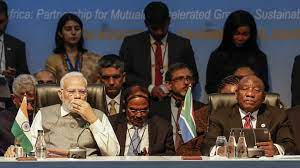Daily News Analysis.
The Places of Worship Act, 1991
- The Places of Worship Act, of 1991, is an important piece of legislation in India that seeks to maintain the status quo of religious places of worship as they existed on August 15, 1947.
- This act was enacted to prevent the conversion of religious places and to maintain communal harmony by ensuring that no place of worship is altered or demolished to accommodate the religious sentiments of one community at the expense of another.
- Some groups and individuals argue that the act should be reconsidered to address historical injustices and to allow for the restoration of places of worship that were forcibly converted or destroyed during periods of conflict. They argue that this could be a step towards reconciliation and religious harmony.
- On the other hand, there are concerns that amending the act could open up a Pandora’s box of disputes and legal battles over religious sites, potentially leading to communal tensions. The act, as it stands, has been seen as a safeguard against such disputes by freezing the status of religious places as of 1947.
The key provisions of the Places of Worship Act, 1991, include
- Maintenance of Status Quo: The act prohibits the conversion of any religious place of worship as it existed on August 15, 1947.
- Prohibition on Alteration or Demolition: It prohibits any structural alteration, addition, or demolition of a religious place that existed on the specified date.
- Legal Bar on Claims: The act also bars courts from entertaining any lawsuits or claims related to the conversion, alteration, or demolition of religious places of worship.
- Exceptions: The act makes exceptions for the maintenance and repair of such places and allows for changes necessary for their proper management.
The Places of Worship Act, 1991, reflects India’s commitment to secularism and communal harmony by preserving the religious heritage of the country. While debates over its potential amendment continue, it remains a significant piece of legislation that seeks to balance the rights and sentiments of diverse religious communities while preventing the escalation of religious conflicts. Its presence in the news underscores the ongoing discussions surrounding religious freedoms, heritage preservation, and the delicate balance between the two in India.
Debt restructuring
- Debt restructuring is a financial strategy employed by governments, businesses, or individuals to manage and alleviate their existing debt burdens.
- It involves the modification of the terms and conditions of debt obligations, such as loans or bonds, to make them more manageable, sustainable, and aligned with the debtor’s financial capabilities.
- Debt restructuring can take various forms, including extending the repayment period, reducing interest rates, or even reducing the principal amount owed.
The impact of debt restructuring on the economy can be significant
- Debt Relief: Debt restructuring can provide immediate relief to debt-laden entities. By easing debt repayment terms, it allows debtors to free up funds for other essential expenditures, such as investments, operations, or economic growth initiatives.
- Stability and Avoiding Defaults: For governments and businesses facing financial distress, debt restructuring can help prevent default on their obligations. Default can have severe consequences, including damage to credit ratings, reduced access to capital markets, and increased borrowing costs. Debt restructuring can mitigate these risks and maintain financial stability.
- Economic Growth: When businesses and governments have more manageable debt loads, they are better positioned to invest in infrastructure, job creation, and economic development. This can stimulate economic growth, increase employment opportunities, and enhance overall prosperity.
- Investor Confidence: A well-structured debt restructuring plan can restore investor confidence. When investors see a clear path to debt repayment and financial recovery, they are more likely to continue investing in the affected entity, which can stabilize financial markets and attract foreign investment.
- Cautions on Moral Hazard: While debt restructuring can provide relief, it must be carried out carefully to avoid moral hazard. If creditors believe that borrowers will always be bailed out through debt restructuring, they may lend irresponsibly in the future, exacerbating the problem. Effective regulatory frameworks and responsible lending practices are essential to mitigate this risk.
- Long-term Fiscal Sustainability: For governments, debt restructuring can be a tool to achieve long-term fiscal sustainability. By restructuring debt and reducing debt service costs, governments can allocate resources to critical public services, such as education, healthcare, and social programs, without resorting to excessive taxation.
- Potential Downsides: Despite its benefits, debt restructuring can have downsides, such as reduced creditworthiness, increased interest rates for future borrowing, and strained relationships between debtors and creditors.
In conclusion, debt restructuring is a valuable financial tool that can provide relief, stability, and the potential for economic growth. However, its impact on the economy depends on how it is implemented and whether it is accompanied by responsible financial management and regulatory oversight to ensure long-term fiscal sustainability. When carried out judiciously, debt restructuring can be an effective means of addressing financial challenges and promoting economic well-being.
Infertility rates in the southern states of India
Infertility rates in the southern states of India have become a topic of concern and discussion in recent years. While infertility is a complex issue influenced by various factors, including lifestyle, genetics, and healthcare access, there are certain patterns and trends that can be observed in the southern states of India.
- Delayed Marriages and Childbearing: In many southern states, there is a trend towards delayed marriages and childbearing, particularly among urban populations. This delay can contribute to higher infertility rates, as a woman’s fertility typically declines with age. Pursuit of education, career aspirations, and changing societal norms are some of the reasons for this delay.
- Urbanization and Lifestyle Factors: The rapid urbanization seen in states like Karnataka, Tamil Nadu, and Andhra Pradesh has led to changes in lifestyle and diet. Urban populations often have higher stress levels, sedentary lifestyles, and exposure to environmental pollutants, all of which can impact fertility negatively.
- Awareness and Seeking Treatment: The southern states generally have better healthcare infrastructure and awareness compared to some other regions in India. As a result, more couples in the south are seeking medical help for infertility, which could contribute to the perception of higher infertility rates.
- Access to Assisted Reproductive Technologies (ART): Southern states are also known for having a higher concentration of fertility clinics and centers offering assisted reproductive technologies like in vitro fertilization (IVF) and intrauterine insemination (IUI). While this facilitates access to infertility treatment, it may also contribute to the perception of higher infertility rates.
- Social and Cultural Factors: Southern states have their own unique social and cultural norms that can influence fertility. These include family structures, expectations regarding childbearing, and gender roles.
- Genetic Factors: Genetic factors can also play a role in infertility rates, and the prevalence of specific genetic conditions can vary among different populations.
- Government Initiatives: Some southern states have implemented government initiatives to address fertility issues, such as providing financial assistance for infertility treatments, which could lead to higher reporting of cases.
Overall, while infertility rates may be relatively higher in some southern states, the factors contributing to these rates are multifaceted and complex, and addressing them requires a holistic approach involving healthcare, education, and societal changes.
African union becoming G20 members
- In addition to suggesting that the African Union (AU) become a full member of the Group of 20, Indian Prime Minister Narendra Modi is positioning his nation as the answer to supply chain problems ahead of the bloc’s summit in New Delhi next month.
- The African Union has been invited to join the G20 permanently as part of our inclusive vision, Modi stated on Sunday at the Business 20 Summit in New Delhi, days before the G20 summit on September 9–10, 2018.
- With 19 nations and the European Union (EU) making up the G20 major economies, which account for over 85% of the world’s gross domestic product (GDP) and two-thirds of its population, only South Africa is a member of the continent.
- The AU should “join the G20 as a permanent member,” US President Joe Biden said in December, adding that it had “been a long time coming, but it’s going to come.”
- On Sunday, New Delhi urged the inclusion of the Pan-African group, whose combined GDP reached $3 trillion in 2017.
- India has turned into the biggest consumer of Russian crude by refusing to follow the West’s policy of isolation against Moscow.
Avalanche in Sumeru mountains
- The “Sumeru Mountains” are a term often used in ancient Indian literature to describe the mythical or metaphorical center of the universe, and they are not a real geographical feature.
- However, avalanches can occur in many mountainous regions around the world, and it’s important to discuss the general characteristics and impact of avalanches in such areas.
- Avalanches are natural disasters characterized by the sudden, rapid downhill movement of snow, ice, and debris on a mountain slope. While avalanches are not exclusive to any particular mountain range, they can occur in various high-altitude regions, including the Himalayas.
Here are key points about avalanches in mountainous areas like the Himalayas
- Causes: Avalanches typically occur due to a combination of factors, including heavy snowfall, temperature changes, wind patterns, and the steepness of the terrain. These factors can destabilize the snowpack, leading to a release of snow.
- Impact: Avalanches can be extremely destructive. They have the potential to bury villages, damage infrastructure, and cause loss of life. The impact can be particularly severe in regions where communities are located in close proximity to steep mountain slopes.
- Warning Systems: In regions prone to avalanches, there are often avalanche warning and monitoring systems in place. These systems use various techniques, including snowpack analysis and weather monitoring, to predict and mitigate the risk of avalanches.
- Mitigation Measures: Avalanche mitigation measures include controlled explosions to trigger smaller, controlled avalanches to reduce the risk of larger, uncontrolled ones. Additionally, infrastructure like avalanche barriers and deflection walls may be installed to protect vulnerable areas.
- Rescue and Preparedness: In regions at risk, local authorities and communities are trained in avalanche rescue techniques. Preparedness and quick response are crucial in saving lives when avalanches occur.
- Climate Change: Climate change has been linked to changes in avalanche patterns. Rising temperatures can affect snowpack stability and increase the risk of avalanches in some areas.
- Tourism: Some mountainous regions, including parts of the Himalayas, attract tourists for activities like skiing and mountaineering. It’s important for tourists and adventurers to be aware of avalanche risks and follow safety guidelines.
They are a natural hazard that affects mountainous regions globally. Understanding the causes, impact, and mitigation strategies associated with avalanches is essential for the safety and well-being of those living in or visiting these areas. Mountain communities and governments must remain vigilant and proactive in managing the risks posed by avalanches to ensure the safety of their residents and visitors.
Anit-Polygamy Law in Assam
- A three-person committee has been established by the Assam government to write the proposed anti-polygamy law. Its members include the Director General of Police, the Legal Remembrancer, and the General Advocate.
- The state administration had earlier created a committee to look into the “legislative competence of the state legislature” to draught a bill to outlaw polygamy.
- “We wanted to see first if the state had the authority to outlaw polygamy. We had established a committee, with Justice Rumi Phookan, a retired judge from the Gauhati High Court, serving as its head.
- “We had pledged to enact a law prohibiting love jihad prior to the most recent Assembly elections. After discussing both polygamy and love jihad, we moved forward to enact the law. A new committee has been established, and its task is to write the proposed anti-polygamy law.
- The Muslim Personal Law (Shariat) Act, 1937’s provisions and Article 25 of the Indian Constitution had naturally been examined by the previous committee in regard to the guiding concept of state policy for a unified civil code.
- He had claimed that educated and native Muslims almost seldom practice polygamy. For instance, Assam’s Jamunamukh and Hojai and the Barak Valley in southern Assam.









